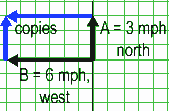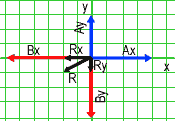pp 13 - 23 of your lab book
A vector is a quantity which has both magnitude and direction. (Examples: displacement, velocity, acceleration, force)
A scalar is a quantity which has only a magnitude but no direction. (Examples: mass, temperature, energy, time)
A vector is represented graphically by an arrow. Mathematically, there are many kinds of notation for vectors. One way to distinguish a vector is by drawing an arrow on the top of a variable,
A scalar adds normally. It is correct to say that 3 kg + 6 kg = 9 kg.
On the other hand, vectors do not add in the normal way. It would be incorrect to say 3 mph, north + 6 mph, west = 9 mph, north-west.
How do vectors add?
1. The graphical method:
This method uses a graph to determine the result of A + B . It requires a ruler and protractor.
Example: I want to add the vectors A = 3 mph, north and B = 6 mph, west.
|
Draw
both vectors on a graph.
|

|
| Copy
the vector B and move the copy to the tip of the vector
A , without changing the angle of B
. Copy A and move it to the tip of vector B. I now have a parallelogram. |

|
| Draw
an arrow from the tail of (the original) A to the tip of
B . This is the resultant vector,
R. |

|
If you measure the length of R, you will get about 6.7 mph (because the scale is in mph). This is the magnitude of R. The magnitude of a vector is a scalar, and is written with no underline, R. If you measure the angle, you will find it is about 153 degrees from the x axis.
2. The Analytical Triangle Method:
This method uses the law of sines and the law of cosines to solve for R, given two arbitrary vectors A and B . I will not emphasize this method. If you wish for me to show you how these equations come about, I can do this in class or you can ask me during my office hours. This method is not used very often, although I will ask you to remember the formulae below for the quiz next meeting.
Given a vector A and a vector B with a known angle
the squared
length of the resultant vector is R2 = A2 +
B 2 + 2AB cos .
.
the angle
of the resultant vector is  = sin-1(B sin
= sin-1(B sin /R), where
/R), where  is measured from the vector A.
is measured from the vector A.
3. The Analytical Component Method:
This method finds the resultant vector by first splitting up the vectors into components. While vectors do not add normally, similar components do!
The Force Table3. The Analytical Component Method:
This method finds the resultant vector by first splitting up the vectors into components. While vectors do not add normally, similar components do!
| Split
up the vector A into x and y components. If you are given the angle Ax
= A cos
Ay
= A sin
|

|
| Split
up the vector B into components. Bx
= B cos
By
= B sin
|

|
| Now
add together the components. Components add normally. Rx
= Ax + Bx
Ry
= Ay + By
The
squared magnitude of the resultant is
R
2 = Rx2 + Ry2
The angle of the resultant
vector is given byangle
= tan-1(Ry/Rx)
(Beware your calculator
returns a value of -90 to 90 degrees for tan-1)This resultant vector is shown in black on the graph |

|
A force is a push or pull. Forces are vectors. Since they are vectors, we will add forces using the three methods above and compare these values with the measurements we make. The force we will use is the force of gravity acting on mass (also known as weight).
We will add these forces by hanging a rope with a mass attached to it on a circular table we will call a force table. We will have two masses which we want to add and a third mass which is used to balance the summed force. If the apparatus is in balance, then the third force and the summed force are equal in magnitude.



